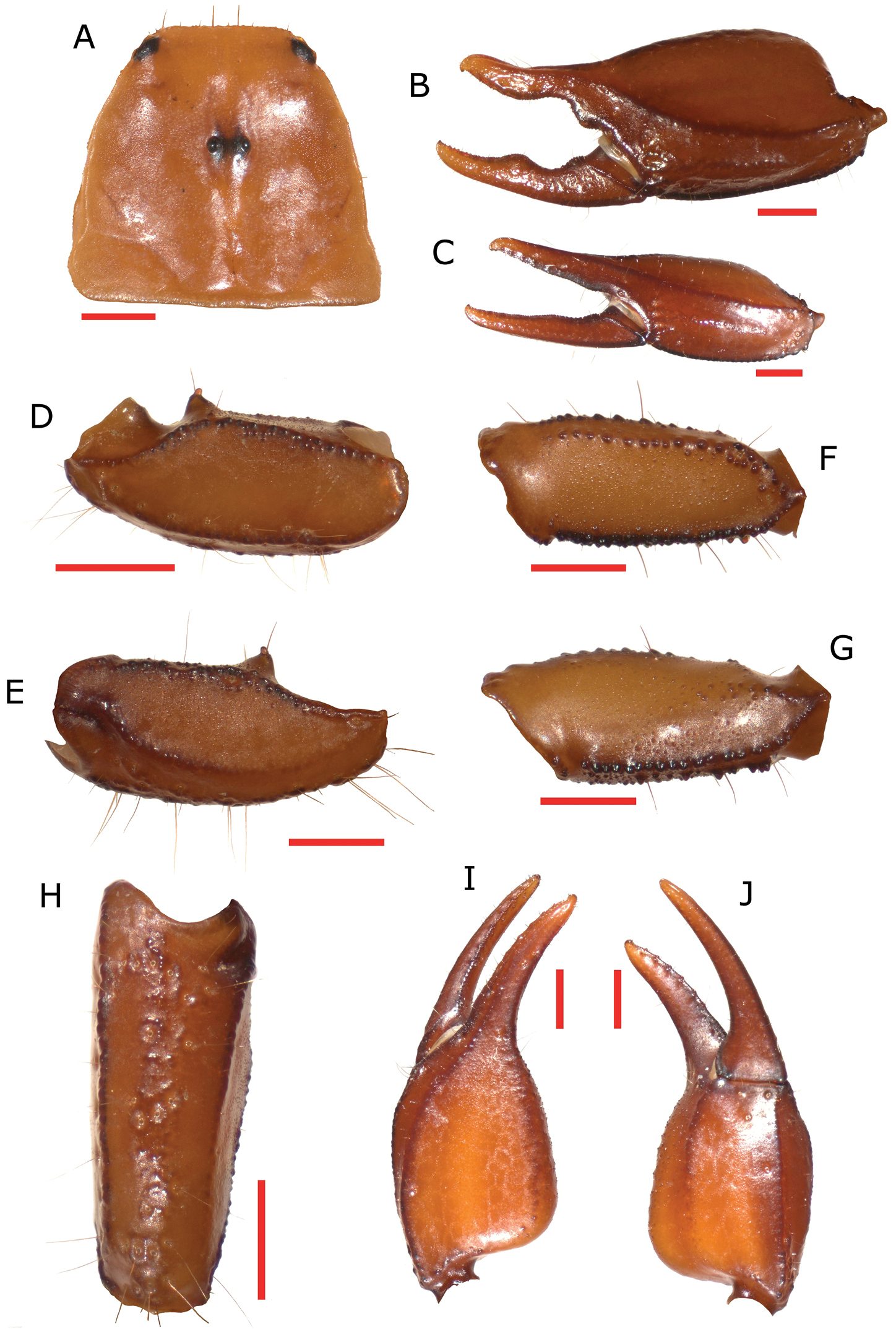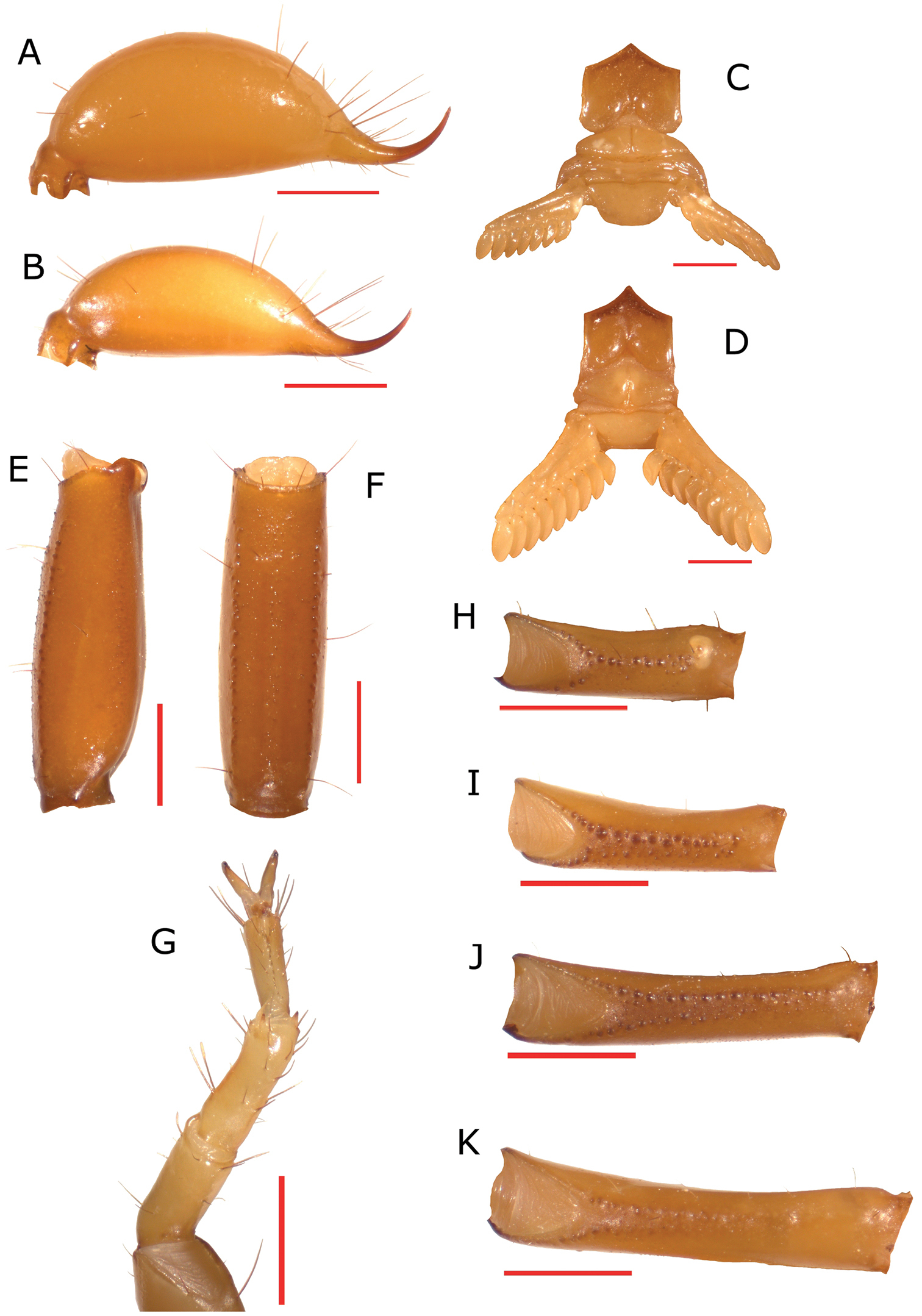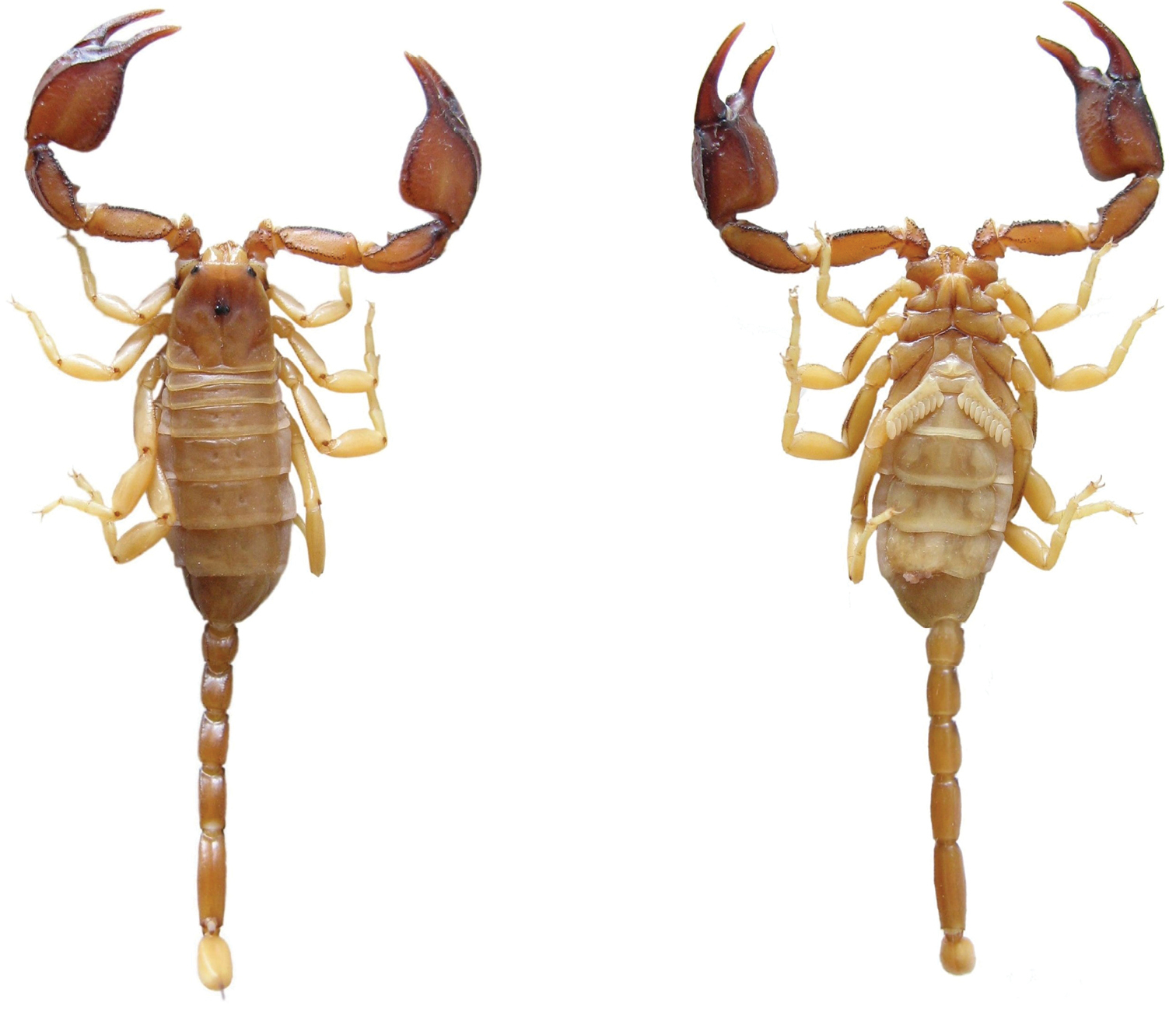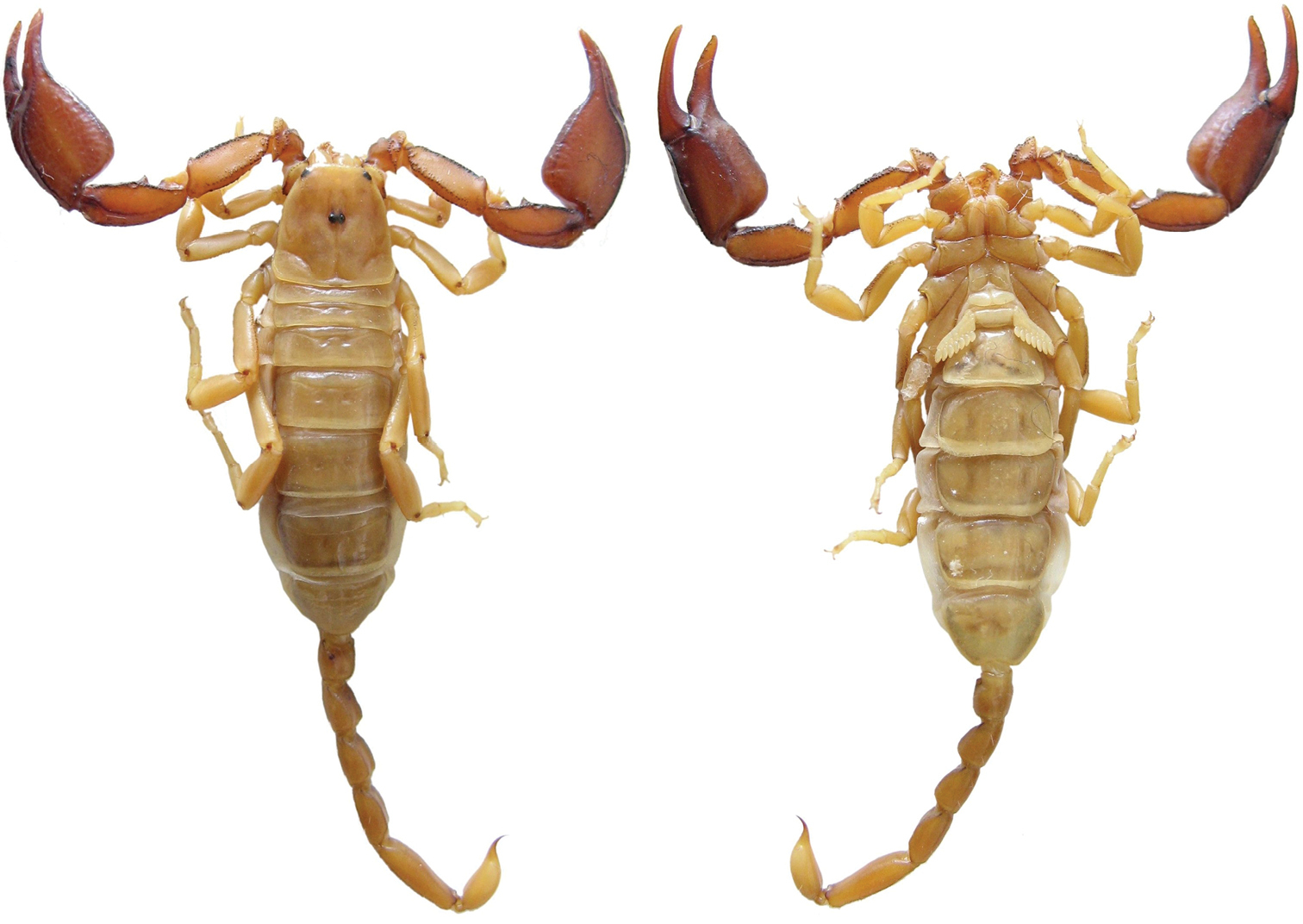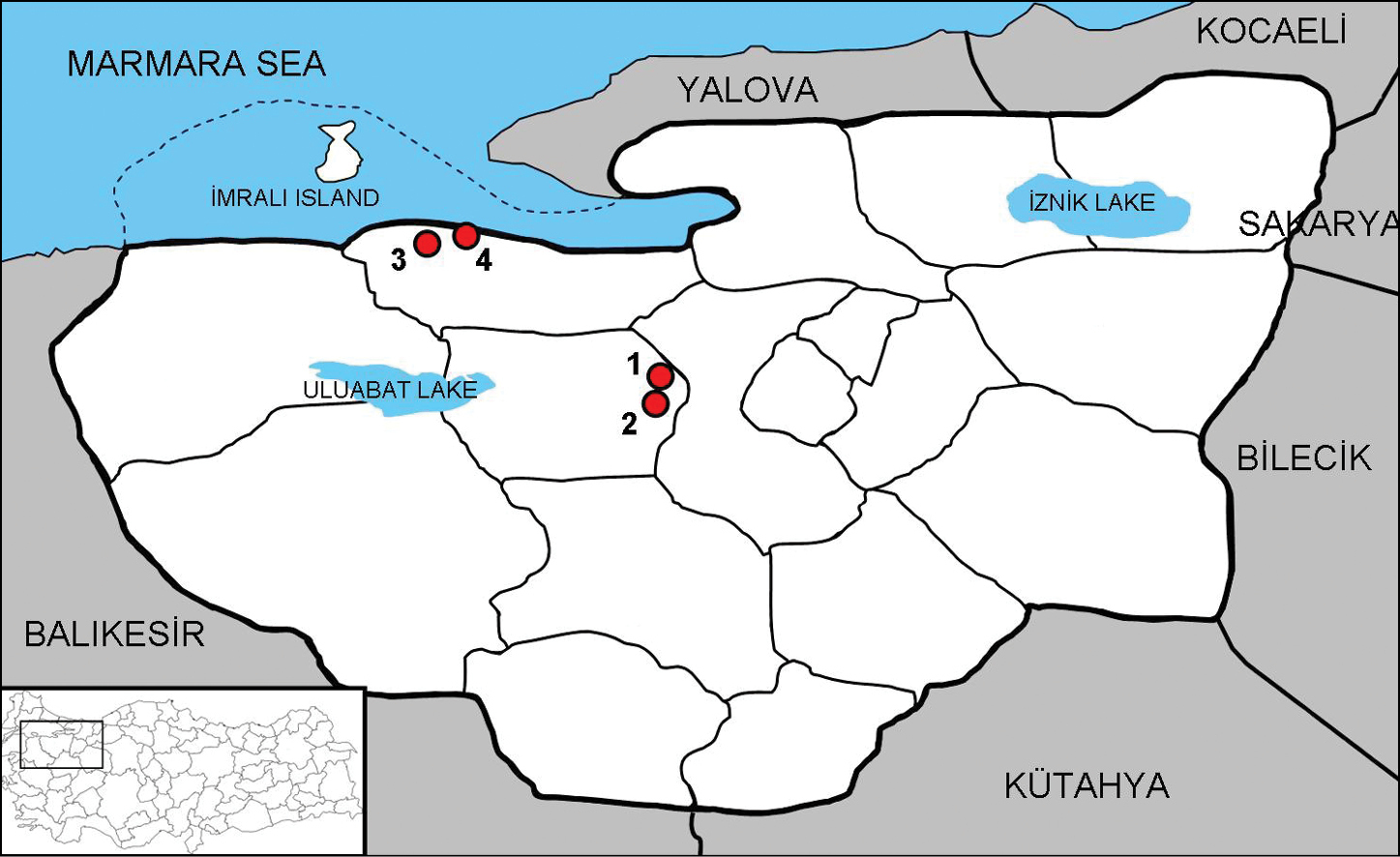






(C) 2013 Ersen Aydın Yağmur. This is an open access article distributed under the terms of the Creative Commons Attribution License 3.0 (CC-BY), which permits unrestricted use, distribution, and reproduction in any medium, provided the original author and source are credited.
For reference, use of the paginated PDF or printed version of this article is recommended.
A new species of the genus Euscorpius Thorell, 1876 is described based on specimens collected from Bursa Province, in Marmara Region of Turkey. It is characterized by a mesotrichous trichobothrial pattern (Pv= 8, et= 6, em=4, eb= 4), medium size and light coloration. Euscorpius (Euscorpius) rahsenae sp. n. is the second species of the subgenus Euscorpius recognizedin Turkey.
Scorpion, Euscorpius, new species, Turkey
The genus Euscorpius Thorell, 1876 is one of the most studied taxa of scorpions, however, because of its complexity, its taxonomy continuously changes and is not completely clear, especially in the Balkans, Turkey and in Western Europe. The Euscorpius populations of Turkey have been poorly studied, and only three valid species are recognized: Euscorpius (Polytrichobothrius) italicus (Herbst, 1800), Euscorpius (Alpiscorpius) mingrelicus (Kessler, 1874) and Euscorpius (Euscorpius) avcii
Presence of the subgenus Euscorpius in Turkey have been reported many times, under the name of Euscorpius carpathicus or Euscorpius carpathicus “complex” from İstanbul (
The new species described herein, Euscorpius (Euscorpius) rahsenae sp. n. is the second species of the subgenus Euscorpius s.str. in Turkey.
A total of 59 specimens belonging to the new species were collected from Bursa Province, in the Marmara region of Turkey. Comparison material: Euscorpius avcii, holotype ♂, Dilek Peninsula National Park, Canyon, Dilek Peninsula, near Davutlar Town, Kuşadası, Aydın, Turkey, 07.10.2005, leg. H. Koç (MTAS); paratypes, 1 ♂, 5 ♀♀, Dilek Peninsula National Park, Canyon, Dilek Peninsula, near Davutlar Town, Kuşadası District, Aydın Province, Turkey, 07.10.2005, leg. H. Koç (MZUF); same data, 1 ♂, 2 ♀♀ (GTC); Abbreviations: V: trichobothria on ventral pedipalp chela manus; Pv: trichobothria on patella ventral surface; Pe: trichobothria on the pedipalp patella external surface; et: external terminal; est: external subterminal; em: external medium; esb: external suprabasal; eba: external basal a; eb: external basal; DPS: dorsal patellar spur; DD: distal denticle; MD: median denticles; OD: outer denticles; ID: inner denticles; IAD: inner accessory denticles; MZUF: Museo Zoologico ‘La Specola’ dell’Università di Firenze, Florence, Italy; GTC: private collection of Gioele Tropea, Rome, Italy; MTAS: Museum of the Turkish Arachnological Society; MSNB: Museo Civico di Scienze Naturali “E. Caffi”, Bergamo, Italy; ZMSU: Zoology Museum of Sinop University, Turkey; KUAM: Arachnological Museum of Kırıkkale University, Turkey; AZM: Alaşehir Zoological Museum, Celal Bayar University, Manisa, Turkey; FKCP: František Kovařík Collection, Praha, Czech Republic.
The trichobothrial notations follow
urn:lsid:zoobank.org:act:9D78689F-F701-4CD5-9B79-A58BA80D88A4
Holotype: 1♂, Tirilye Village, Mudanya District, Bursa Province, Turkey, 06.07.2012, 40°23'08.9"N, 28°48'20.9"E, 39 m, Red Pine Forest, leg. R.S. Kaya & H. Koru (AZM).
Paratypes: 1. 1♀. Beşevler Neighborhood, Nilüfer District, Bursa Province, 23.06.2004, 21.04.2012, 40°12'46"N, 28°57'58"E, 140 m, leg. R.S. Kaya (AZM). 2. 1♀. Beşevler Neighborhood, Nilüfer District, Bursa Province, 05.05.2005, 40°11'47"N, 28°57'58"E, 153 m, leg. R.S. Kaya (AZM). 3. 3♀♀. Yalıçiftlik Village, Ruined Building, Mudanya District, Bursa Province, 21.04.2012, 40°21'16"N, 28°42'58"E, 97 m, leg. H. Koru (AZM). Same data, 1♂, 23.10.2012. 4. 1♂, 1♀. Tirilye Village, Mudanya District, Bursa Province, 17.06.2012, 40°23'08.9"N, 28°48'20.9"E, 39 m, leg. E.A. Yağmur & R.S. Kaya (GTC). Same data, 6♀♀ (AZM). Same locality 4♂♂, 3♀♀, 06.07.2012, leg. R.S. Kaya & H. Koru; 3♂♂, 7♀♀, 22.09.2012, leg. R.S. Kaya & H. Koru (GTC). Same data 1♂, 1♀ (MSNB). Same data 2♂♂, 9♀♀ (AZM). Same locality 2♂♂, 8♀♀, 06.11.2012, leg. R.S. Kaya & H. Koru (AZM), 1♂, 1♀ (FKCP). 5. 1♂, 1♀. Çiftehavuzlar Neighborhood, Karadeniz Street, Osmangazi District, Bursa Province, 28.10.2012, 40°12'30"N, 29°03'05"E, 110 m, Home garden, leg. H. Koru (AZM).
The specific epithet refers to Dr. Rahşen S. Kaya, a Turkish arachnologist, for her friendship and kind contributions to collecting scorpions.
A medium Euscorpius species, total length 27–34 mm.Color of adults very light brown-yellowish with carapace and pedipalpslittle darker, legs, telson and chelicerae lighter. Carinae dark, distinctly brownish-blackish, especially on pedipalps. Dark lines in the external or distal part of the coxa and sternum.The number of trichobothria on the pedipalp manus ventral surface is 4 (3 V + Et 1); the number of trichobothria on the pedipalp patella ventral surface is 8(in 87.29% of examined pedipalps); the number of trichobothria on pedipalp patella external surface is: eb = 4, eba = 4, esb = 2, em = 4, est = 4, et = 6 ( in 77.96% of examined pedipalps).The pectinal teeth count is 9 (in 80.55% of examined pectines) in males, 7 (in 68.29% of examined pectines) in females.The telson vesicle in males is considerably more swollen than in females: average L/H ratio of the vesicle is 2.07 in male and 2.30 in females.Chela with a notch on fixed finger and scalloping of the movable finger in adult males, obsolete in females.Dorsal patellar spur well developed. Average L/W ratio of the chela is 2.35 in males and 2.48 in females. Average length/posterior width ratio of the carapace is 0.98. All carinae on pedipalps are strongly distinct and dark, in contrast with clear color of tegument.Average value of the length from center median eyes to anterior margin of the carapace is 42.47% of the carapace length. Average value of the length from center median eyes to posterior margin of the carapace is 57.53% of the carapace length.
Coloration: Very light brownish with carapace and pedipalps little darker, legs, telson and chelicerae are lighter. The carinae are dark, distinctly brownish-blackish, especially on pedipalps. Dark lines in the external or distal part of the coxa and sternum. Granulometry on the femora of the legs, especially ventrally, dark. The sternites, pectines and genital operculum are very light brownish-white.
Carapace: Length 4.11 mm; posterior width 4.14. Very finely granulated. Distance from the center of the median eyes to the anterior margin of the carapace is equivalent to 42.33% of the prosoma; the length from the center of the median eyes to the posterior margin of the carapace is equivalent to 57.67% of the prosoma.
Mesosoma:Tergites veryfinely granulated; sternites finely punctate. The area of overlap between the sternites is lighter in color. Pectinal teeth count is 9-9. The spiracles are very small, oval-shaped and it is inclined about 45° downwards towards outside.
Metasoma: Medium size with respect to body length. Dorsal carinae from segment I-IV are granulated, exhibiting dark granules, obsolete on the segment V; ventromedian carinae from segment I-IV absent; ventromedian carinae on segment V are formed by fine granules; ventrolateral carinae on segment I absent, on segments II and III smooth, on segment IV is formed by small dark granules, on segment V is formed by dark granules; all intercarinal spaces are finely granulated.
Telson: Vesicle weakly swollen; smooth, with ventral setae of different sizes; telson height 1.38; telson length 3.75; vesicle length 2.85; vesicle width 1.38; L/H ratio of the vesicle 2.06.
Pectines:Pectinalteeth count 9-9; middle lamellae count 6-6.
Genital operculum:Partially divided with genital papillae protruding; a few microsetae present.
Sternum:Pentagonal shape, type 2. Length similar to width, deep posterior emargination.
Pedipalp: Coxa and trochanter with strong granulation.Femur: dorsal internal carinae tuberculate;dorsal external carinae formed by tubercles, slightly serrulated; intercarinal spaces granulated; external median carinae serrulate, anterior median formed by hardly conical tubercle. Patella length 3.54; patella width 1.38; dorsal internal carinae crenulate to tuberculate; dorsal external carinae low, from rough to crenulate; Ventral external carinae crenulate; ventral internal carinae from serrulate to tuberculate; dorsal intercarinal tegument with granules of increased size from proximal to distal area; ventral intercarinal tegument from smooth to minutely granulate with a few bigger granules near to ventral internal carinae; internal intercarinal tegument uniformly finely granulate. Dorsal patellar spur averagely developed (Fig. 1E). Chelal carina D1 isdistinctly strong, dark and from smooth to rough; D4 is rough with a few low granules in proximal area;V1 isdistinctly strong, from rough to crenulate and dark; V3 dark on ¾ of length, mostly smooth with a few scattered minuscule granules; external carina rough and dark; intercarinal tegument from smooth to rough except between carinae D4 and V3, granulate. Movable finger dentition: MD form a straight line of very small denticles closely spaced with a DD on the distal tip; OD formed of 7 denticles on movable finger and 6 denticles on fixed finger, immediately outside of MD, their size increases progressively but the terminal denticle is not very pronounced; ID formed of 7 denticles on movable finger and 6 denticles on fixed finger, spaced from MD, their size increases progressively but the terminal denticle is not very pronounced; IAD on both movable and fixed finger formed of 4 small denticles; L/W ratio of the chela 2.35
Trichobothria: Chela trichobothria series V standard: V = 4-4 (3 V+ Et1); patella ventral (Pv): 8-8; Patella external (Pe): et = 6-6, est = 4-4, em = 4-4, esb = 2-2, eba = 4-4, eb = 4-4.
Legs: legs with two pedal spurs. Tarsal ventral row with 10-12 stout spinules (including the ventral distal spinule pair); 3 flanking pairs of tarsal setae adjacent to the ventral spinules row.Basitarsus with 6-7 prolateral stout spinules on leg pair I; 4-3 prolateral stout spinules on leg pair II; absent on leg pair III and IV. Dark granulation present above leg femora, mostly ventrally; on the dorsal leg femora I it is weakly marked and of lighter color.
Chelicerae: smooth, without marbling, with darker teeth; the dorsal distal tooth is smaller than the ventral distal tooth; ventral edge is smooth with brush-like setae on the inner part; dorsal edge has five teeth: one distal, two small subdistal, one big median and a small basal; fixed finger has four teeth: one distal, one subdistal, one median and one basal; the median and the basal are in a fork arrangement; the internal edge has brush-like setae.
Variation: The variation observed in 59 studied specimens (18 males, 41 females) as follows: pectinal teeth in males: 8-8 (2/18), 8-9 (1/18), 9-9 (13/18), 9-10 (2/18); females: 6-6 (1/41), 6-7 (3/41), 7-7 (23/41), 8-7 (7/41), 8-8 (6/41), 8-9 (1/41); pedipalp patella trichobothria Pv: 7-7 (2/59), 8-7 (10/59), 8-8 (46/59), 9-8 (1/59); pedipalp patella trichobothria Pe: et = 5-5(6/59), 5-6 (14/59), 6-6 (39/59); est = 3-4 (2/59), 4-4 (57/59), em = 4-4 (59/59), esb= 2-2 (59/59), eba = 4-4 (59/59), eb = 4-4 (59/59). The variation in the trichobothrial pattern is within the standard values of variability and shows the stability of diagnostic characters.
Hemispermatophore: Well developed lamina with well visible basal constriction, tapered distally; truncal flexure present and well developed; capsular lobe complex well developed, with acuminate process; ental channel spinose distally, exhibiting 8-12 delicate spines.
A carapace B external view of chela of the adult male C external view of chela of the adult female D ventral view of pedipalp patella E dorsal view of pedipalp patella F ventral view of pedipalp femur G dorsal view of pedipalp femur H view of external surface of pedipalp patella I dorsal view of chela J ventral view of chela.
A telson of adult male B telson of adult female C sternopectinal area of adult female D sternopectinal area of adult male E latero-dorsal view of the metasomal segment V F ventral view of the metasomal segment V G tarsus and basitarsus H leg femur I I leg femur II J leg femur III K leg femur IV.
Dorsal and ventral views of Euscorpius rahsenae sp. n. male.
Dorsal and ventral views of Euscorpius rahsenae sp. n. female.
Left hemispermatophore of Euscorpius rahsenae sp. n.
Sampling map of Euscorpius rahsenae sp. n. in Bursa Province
The pine forest habitat in Tirilye Village.
The ruined building habitat in Yalıçiftlik Village.
Measurements (in mm) of male holotype and female paratype of Euscorpius rahsenae sp. n.
| Holotype | Paratype female | ||
|---|---|---|---|
| Total | Length | 28.86 | 28.21 |
| Carapace | Length | 4.11 | 4.06 |
| Posterior width | 4.14 | 4.14 | |
| Metasoma | Length | 11.40 | 10.34 |
| Segment I | Length | 1.50 | 1.32 |
| Width | 1.49 | 1.38 | |
| Segment II | Length | 1.80 | 1.62 |
| Width | 1.26 | 1.13 | |
| Segment III | Length | 1.98 | 1.85 |
| Width | 1.20 | 1.08 | |
| Segment IV | Length | 2.34 | 2.16 |
| Width | 1.14 | 1.02 | |
| Segment V | Length | 3.78 | 3.39 |
| Width | 1.14 | 1.02 | |
| Telson | Length | 3.75 | 3.30 |
| Vesicle | Length | 2.85 | 2.31 |
| Width | 1.38 | 1.06 | |
| Height | 1.38 | 1.02 | |
| Aculeus | Length | 0.90 | 0.99 |
| Femur | Length | 3.42 | 3.42 |
| Width | 1.32 | 1.32 | |
| Patella | Length | 3.54 | 3.53 |
| Width | 1.38 | 1.44 | |
| Chela | Length | 7.20 | 6.96 |
| Width | 3.06 | 2.72 | |
| Movable finger | Length | 4.20 | 3.90 |
Euscorpius koschewnikowi was described by Birula (1900) from Mt Athos, Agion Oros, in the northeast of Greece.
The only valid species belonging to the subgenus Euscorpius in Turkey is Euscorpius avcii. This species was recently described from Dilek Peninsula as an oligotrichous, small Euscorpius, with a length of 24-28 mm, light brown to brown-reddish colored with the carapace and pedipalps darker and legs and telson lighter (
The other forms of the subgenus Euscorpius are obviously different species and geographically distant. Below, we compare Euscorpius rahsenae sp. n. to some other forms present in the Aegean area: Euscorpius sicanus (C. L. Koch, 1837), Euscorpius carpathicus candiota Birula, 1903, Euscorpius carpathicus scaber Birula, 1900, Euscorpius carpathicus ossae Di Caporiacco, 1950 and Euscorpius carpathicus aegaeus Di Caporiacco, 1950.
Euscorpius sicanus complex is widespread in mainland Greece and some Aegean islands (
Euscorpius carpathicus candiota is a light colored species, described from Crete. It can be distinguished by the Euscorpius rahsenae sp. n. by the higher number of trichobothria and pectinal teeth; Pv = 9/10 (usually 10), Pe-et = 6/8 (generally 7) and pectinal teeth count 9 to 10 in males (generally 10) and 7 to 8 in females, compared to Pv = 8, Pe-et = 6 and pectinal teeth count 9 in males and 7 in females.
Euscorpius carpathicus scaber is a scorpion from the northern Aegean area, with a dark coloration, an higher number of pectinal teeth, an higher trichobothrial pattern, and in addition, a body totally covered by granules of various size, as also the name suggests, whereas Euscorpius rahsenae sp. n. is light yellowish-brown, without a particularly accentuated granulation. Euscorpius carpathicus ossae is an oligotrichous form, dark brown in colour with lighter legs and telson. It was described from Mount Ossa, in Thessaly. This form can be distinguished mainly by the dark colour, the Pv=7 and et=5, compared with Pv=8 and Pe-et=6 of Euscorpius rahsenae sp. n. Euscorpius carpathicus aegaeus is a light colored form described from the island of Antiparos, in the central-southern part of the Aegean Sea. Probably it is endemic in few islands in the central-south Aegean Sea. In addition, it is described as uniformly light yellow colored and females with pectinal teeth count 8 (
Trichobothrial counts of Euscorpius species discussed in this paper.
| Species | Pv | Pe - et | Pe - est | Pe - em | Pe - esb | Pe - eba | Pe - eb |
| Euscorpius rahsenae sp.n. | 8 | 5-6 (6) | 4 | 4 | 2 | 4 | 4 |
| Euscorpius avcii | 7 | 5-6 (5) | 4 | 4 | 2 | 4 | 4 |
| Euscorpius koschewnikowi | 8 | 5-6 | 4 | 4 | 2 | 4 | 4 |
| Euscorpius carpathicus aegaeus | 7-8 (8) | 5-6 (6) | 4 | 4 | 2 | 4 | 4 |
| Euscorpius carpathicus ossae | 7 | 5 | 4 | 4 | 2 | 4 | 4 |
| Euscorpius carpathicus scaber | 7-10(8/9) | 6 | 4 | 4 | 2 | 4 | 4 |
| Euscorpius carpathicus candiota | 9-10(10) | 6-7(7) | 4 | 4 | 2 | 4 | 4 |
Some specimens of Euscorpius rahsenae sp. n. were collected from city center (Beşevler and Çiftehavuzlar) and in a ruined building in Yalıçiftlik Village (Mudanya District) of Bursa Province. It shows that Euscorpius rahsenae sp. n. penetrates to human settlements and is an anthropotelerant species.
A large part of Mudanya is an urban area, but the Tirilye locality (Mudanya) has vegetation composed of red pine (Pinus brutia Ten.), torch pine (Pinus nigra Arn. subsp. pallasiana (Lamb)), olive trees (Olea europea L.), and maquis vegetation(Quercus sp., Erica arborea L., Juniperus oxycedrus L., Phillyrea latifolia L., Pistacia lentiscus L., Cistus spp., as main shrubs). The specimens were collected in this locality during night trips with UV light when sitting in cracks of the earthen wall along the roadsides in the forest.
We wish to thank Dr. Rahşen S. Kaya and Mr. Hayri Koru for their help during the field trips and collecting the specimens.
